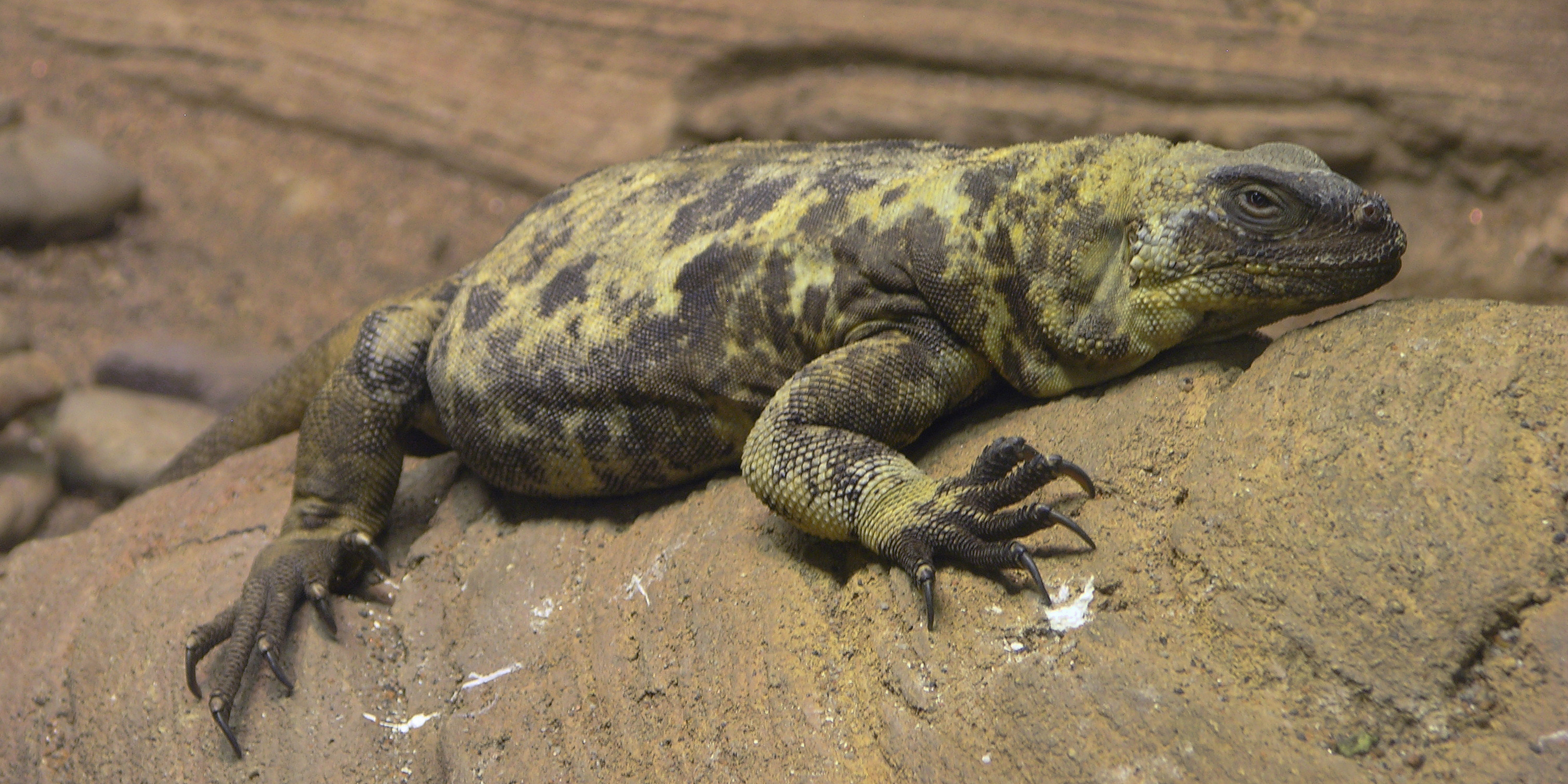- San Esteban Chuckwalla
taxobox
name = San Esteban chuckwallaITIS|ID=586025|taxon=Sauromalus varius|year=2008|date=26 September]
status = EN
status_system = IUCN3.1
regnum =Animal ia
phylum = Chordata
classis = Sauropsida
ordo =Squamata
subordo =Iguania
familia =Iguanidae
genus = "Sauromalus "
species = "S. varius"
binomial = "Sauromalus varius"
binomial_authority = Dickerson, 1919|The San Esteban chuckwalla ("Sauromalus varius") (also known as the Piebald orPinto Chuckwalla) is a species ofchuckwalla belonging to theIguanidae family endemic toSan Esteban Island in theSea of Cortés . It is the largest of the five species of Chuckwallas and the most endangered.Taxonomy and etymology
The generic name, "sauromalus", is a combination of two
Ancient Greek words:σαῦρος (sauros) meaning "lizard ". and ομαλυς (omalus) meaning "flat".cite web | last =Schwenkmeyer | first = Dick| title =Sauromalus ater Common Chuckwalla | work = Field Guide| publisher = San Diego Natural History Museum| date = | url = http://www.sdnhm.org/fieldguide/herps/saur-ate.html| accessdate =17 September 2008 ] Its specific name "varius" is Latin for "speckled," in reference to the Chuckwalla's mottled coloration.cite book | last = Hollingsworth | first = Bradford D. | title = The Evolution of Iguanas an Overview and a Checklist of Species | work = Iguanas: Biology and Conservation | publisher = University of California Press | pages = 43–44 | date = 2004 | isbn = 9780520238541 ] It was first described by American herpetologist Mary C. Dickerson in 1919. [Dickerson, M. C. (1919). "Diagnoses of twenty-three new species and a new genus of lizards from Lower California". Bulletin of the American Museum of Natural History. 41 (10): 461–477]The common name "Chuckwalla" derives from the
Shoshone word "tcaxxwal" orCahuilla "caxwal", transcribed by Spaniards as "chacahuala". TheSeri people named originally the island for this species:"Coftécöl lifa" or the Peninsula of the Giant Chuckwalla.cite book | last = Nabhan| first = Gary| title = Singing the Turtles to Sea: The Comcáac (Seri) Art and Science of Reptiles| pages = 350| publisher = University of California Press | date = 2003|ISBN= 0520217314]Distribution and habitat
The San Esteban chuckwalla is endemic to
San Esteban Island in theSea of Cortés .cite book| last=Case|first=T. J.|date= 1982|title= Ecology and evolution of insular gigantic chuckwallas, Sauromalus hispidus and Sauromalus varius|pages=184–212|work= Iguanas of the World|publisher= Noyes Publications|location=Park Ridge, New Jersey|isbn=0815509170] While it is abundant on this small island, it occurs naturally nowhere else and is protected under theEndangered Species Act . At one time theSeri translocated populations of this lizard to other islands in the Sea of Cortés as a food item, however, none of these populations have survived beyond the original population found on San Esteban.Behavior and reproduction
Harmless to humans, these large lizards are known to run from potential threats. When disturbed, the Chuckwalla will gulp air, distend its body and wedge itself into a tight rock crevice. The Chuckwalla will then inflate its body with air in order to entrench itself.Stebbins, Robert C.,(2003) "A Field Guide to Western Reptiles and Amphibians", 3rd Edition. Houghton Mifflin Company, ISBN10: 0395982723]
Males are seasonally and conditionally territorial; an abundance of resources tends to create a hierarchy based on size, with one large male dominating the area's smaller males. Chuckwallas use a combination of colour and physical displays, namely "push ups", head-hobbing, and gaping of the mouth to communicate and defend their territory (see
animal communication ).Chuckwallas are diurnal animals and as they are
exothermic , spend much of their mornings and winter days basking in the sun. These lizards are well adapted to desert conditions; they are active at temperatures of up to 102°F (39°C).Mating occurs from April to July, with 5–16 eggs laid between June and August. The eggs hatch in late September. San Esteban Chuckwallas may live for 25 years or more.
Diet
Chuckwallas prefer dwelling in
lava flow s and rocky areas with nooks and crannies available for a retreat when threatened. These areas are typically vegetated bycreosote bush andcholla cacti which form the staple of their diet as the chuckwalla is primarily herbivorous. Chuckwallas also feed on leaves, fruit and flowers of annuals,perennial plant s, and evenweed s;insect s represent a supplementary prey if eaten at all.Description
The San Esteban chuckwalla is the largest species of Chuckwalla reaching convert|61|cm|in in body length, convert|76|cm|in overall length and weighing up to convert|1.4|kg|lb. It is considered a textbook example of
island gigantism as it is 3 to 4 times the size of its mainland counterparts. Their skin is gray with tan to yellow patches over their entire bodies, and their faces are gray to black. Females are duller in appearance with less patches. Their colorations provide almost perfect camouflage against some of their predators.Human contact
The
Seri considered this species of chuckwalla an important food item due to its large size. [Richard Felger and Mary B. Moser (1985) "People of the desert and sea: ethnobotany of the Seri Indians" Tucson: University of Arizona Press.] Thetribe of Seri who once inhabited San Esteban Island referred to themselves as Coftécöl Comcáac, "People of the Giant Chuckwalla" and named the island for this species.The San Esteban chuckwalla is an endangered species due to hunting from the Seri and the introduction of feral animals such as
rat s andmice which prey upon the chuckwalla's eggs and feral dogs and cats which prey upon the lizards. Due to these factors and overcollection from the pet trade, the species was declared an Appendix I animal under CITES.There is an "In Situ" chuckwalla captive breeding program in
Punta Chueca , a Seri village on San Esteban. A successful "Ex situ " program has also been in place at theArizona-Sonora Desert Museum since 1977. The species is present in private collections and often crossbred with the smallerAngel Island Chuckwalla .References
Wikimedia Foundation. 2010.
